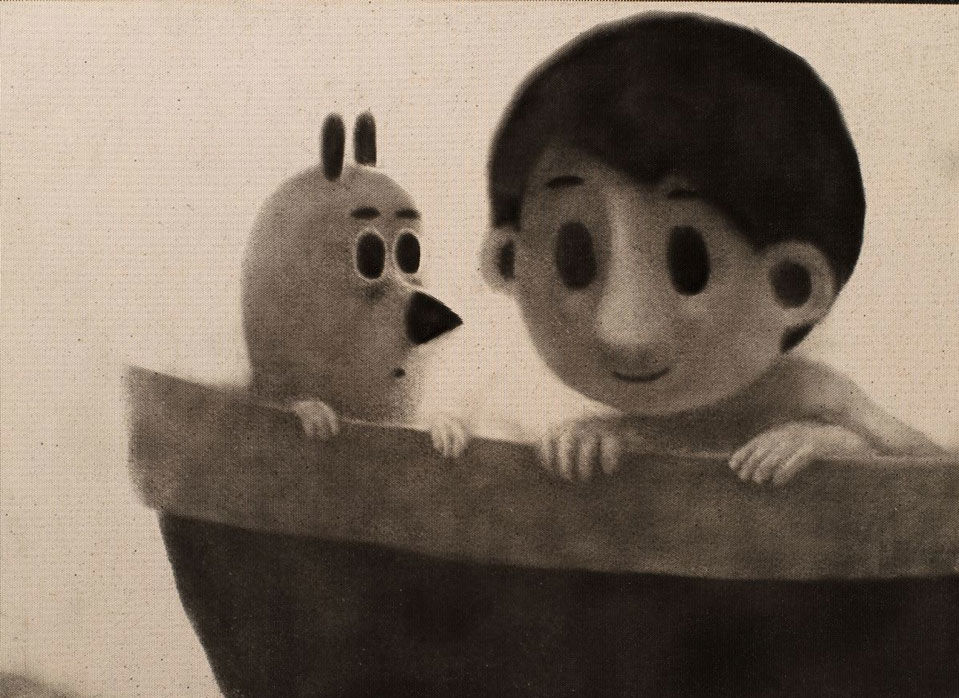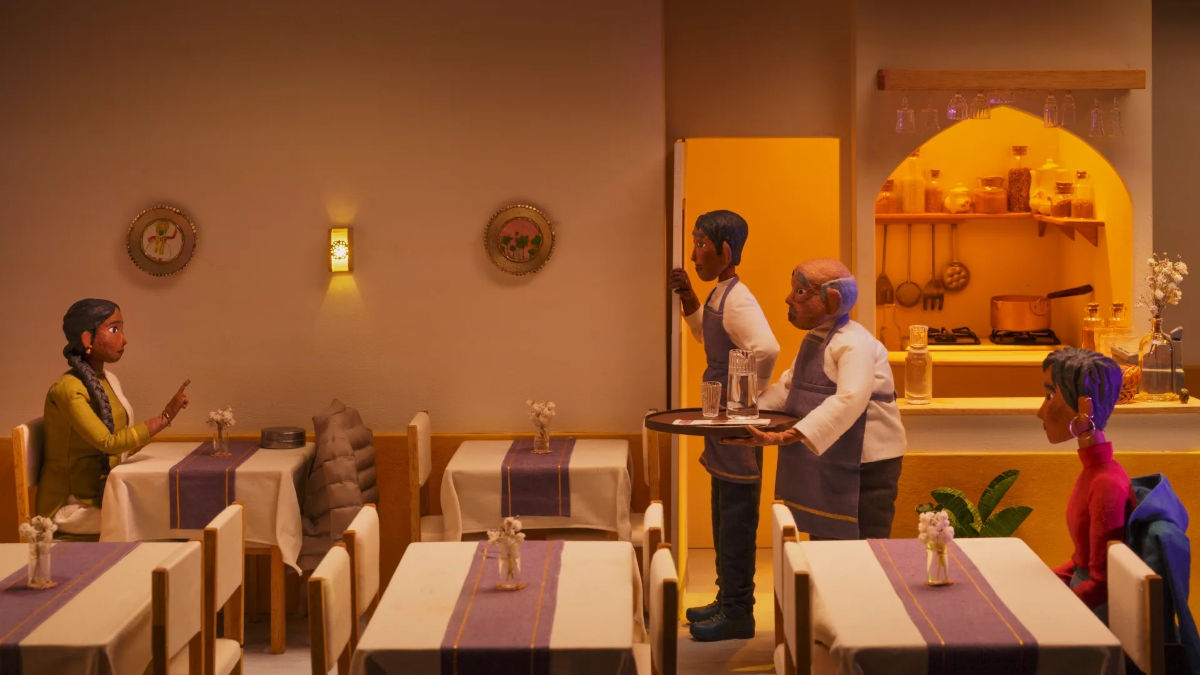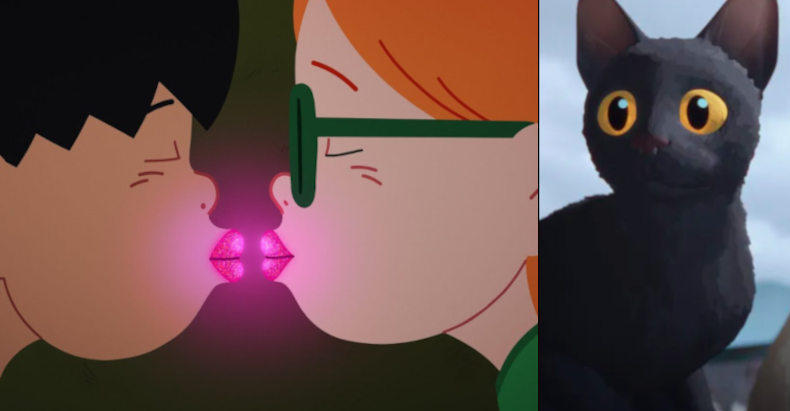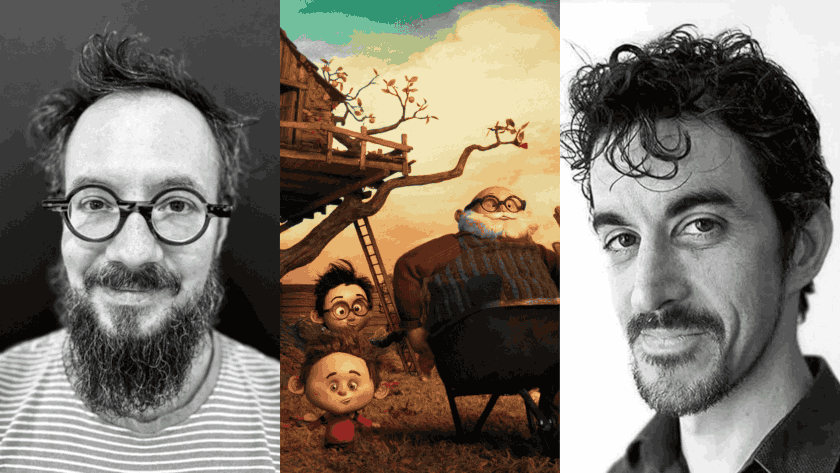Simon Rouby: Even If Festivals Cannot Screen, They Can Still Curate Films (Indie Online 2020 Project)
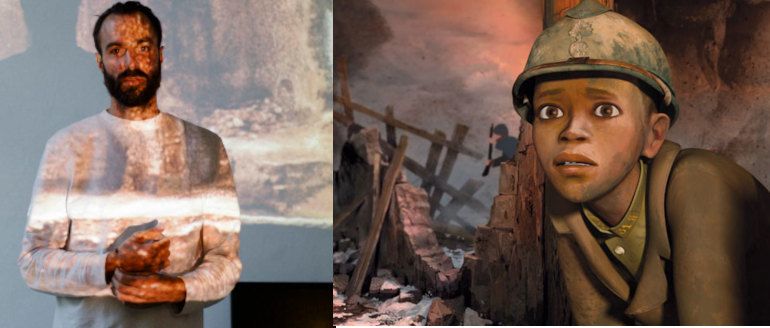
French animation director and artist Simon Rouby made his own international splash when he directed the feature animation film Adama (2015). The film tells the adventures of a young African boy trying to find his brother in the European war field of WWI. Adama was nominated for both the Cesar Awards and the European Film Awards in 2015. Still Simon Rouby, a graduate of Gobelins Paris school, is a multi-faceted artist who can combine both the computer element with the physical, tangible thing. So, it was particularly interesting to check how he himself faced a situation where all physical and tangible issues had to be left on hold, while the online content and life predominated.
Simon Rouby talked to Zippy Frames, as part of the Indie Online 2020 research project (headed by Michelle Kranot, supported by The Animation Workshop, Viborg, Denmark).
VK: If you were to turn the clock back to the first day of March lockdown, where would you find yourself?
SR: I would be exactly where I am now, in Southern France. I had a big video installation that was supposed to open the exact day of the confinement (16th March). So, all days prior to the confinement, I was preparing the show, until it was cancelled 40 hours before the opening. I kind of fled to my hometown in the countryside; to spend what I thought would be only a couple of weeks, but it ended being 12 weeks altogether. The show opened eventually on 1st June - but there was no public opening, no event. I only went back there myself last week - six months later.
VK: Was it attended under the circumstances?
SR: I think it was attended, since they made it last twice as long than it was originally intended to last (2 months). If they hadn't done that, nobody would have seen it since the exhibition space was closed. Most institutional and educational visits, masterclasses, screenings, collateral events etc. were cancelled, so the overall attendance probably suffered a bit.
VK: So, do you consider yourself a victim of this situation?
SR: No, I think I was lucky altogether. In the beginnings, there were a few disappointments of course. I was supposed to go to Kyoto, Japan on the 1st of April for a 3-month residency at Villa Kujoyama; a French residency place in Japan. It was something I was really looking forward to and had planned all my year around, so when it was postponed, I felt that nothing was really going to work out. But I was lucky to have other projects (also postponed, but still maintained). I even participated in a Paris project that was really built through confinement. An unexpected pop-up residency that the Pompidou Center/Museum of Modern Arts put together.
VK: What was the nature of this project, and your own participation?
SR: Since all the cultural buildings and museums of Paris were empty during confinement, and all their summer programs were cancelled, the heads of these institutions talked to each other; they tried to organize a plan B project that would fit the situation. So, instead of running their shows, they invited artists in residency instead. We only heard about it in May, and it was implemented in June and July. It was really last-minute: in French the program was called "Les Moyens du Bord" which means "Do it with the means you have on board".
The proposal was such: there's a space in Paris called La Grande Halle de la Villette, a huge, huge warehouse. 8 artists including myself shared this space; and we had la Villette's technical team with us. It was supposed to be a studio space for us, but at the same time, they wanted to have public in there. So, every Thursday, Friday and Saturday evenings it was open to the public (obviously with restrictions in place). Which meant people would walk into our working spaces, and see us at work. But every artist knows that when public comes in, you can't be just sitting there on your computer, you have to prepare. They didn't impose it, but obviously the situation led to us curating the program ourselves. For 5 weeks in a row, we ended up creating events during the weekends. We shot a video installation live with the public, we created a round table, and invited a number of people to talk. It was never really a studio space for us; it was more like a platform to show and discuss work.
It was opened to contemporary artists only. They didn't invite me because of my film Adama, in fact I am not even sure they were aware of it. It was more about my video installations and performances. (Aside from animation, I also work in the field of contemporary art where my practice feels personally similar, but the output is different.)

VK: How did you feel about this new audience coming? Were they timid to approach you?
SR: First of all, there were fewer people coming to the events because of covid constraints, and there was less of an ability to communicate because of the mask. The fact is that the works on display were very much in the canons of contemporary art, but located in the premises of a very mundane area with a park; you had families walking in quite unprepared. Some people were confused; but it was a good thing. It shook them a little, but at the same time people were like 'there's something there at least' -whatever it was they were happy to see it, because there were very few cultural proposals at the time. They were not necessarily the type of crowd that would actually pay attention to this type of art. So we could say that as events became scarce, a new type of crowd was created.
VK: Suppose you had the means to create a video installation online, would you entertain this possibility?
SR: I am currently working remotely with a US artist, Onye Ozuzu, the Dean of the University of Florida, and the output will be an online video installation. She's American/Nigerian, and she comes from the dance field. I already worked with her last year and flew back and forth to Chicago, something that's not very environmentally friendly; but it went very well as far as the work is concerned. We had already decided that for this new project I wouldn't fly that often, and that we would try to "dematerialize". With the pandemic situation on top of that, there was obviously no other choice.
So, the project involves visiting three places: one in France, one in Nigeria and the third one in Georgia, USA. The purpose was to document these places and create an installation where they would superimpose and become one - thanks to digital tools, such as 3D scanning or video. But working remotely is not easy. Last week she was in Savannah on site, and we were talking through WhatsApp, sharing a lot of photos, videos, etc... I was trying to get inspired through this data transfer, but also struggling because of the 6 hour time zone difference. The "magic" of our collaboration wasn't really happening as easily as in person. Until now we are still trying to "connect" emotionally through the available tools online but it's difficult.
VK: In your Adama film, I recall that you had to set a whole studio at the Reunion island. So, the notion of a common space is very important to you.
SR: I was really trying to avoid the French/ European type of co-production: three different regions within France, and then three different countries involved, so that everyone does a fraction of the film. I was really trying to avoid that. I wanted to create a situation where everyone exists within four walls, information flows naturally, and nothing happens outside of that bubble. I'm attached to having people in front of me.
VK: What about your Pangea feature animation project in development?
SR: Confinement actually helped this project, as I managed to write the script during the lockdown. I suddenly had time to sit, focus and write, something which I had been wanting to do for quite a while, and had previously had a hard time doing because of life happening and other projects getting in the way.
VK: Many people mentioned that they actually had to work harder during the lockdown. Did it actually occur to you that you would be working harder than usual?
SR: During the first March lockdown, I felt more relaxed and peaceful; I was able to focus on one thing at a time, without the usual constant bombardment of new information. But what you describe, I'm experiencing it right now. In September and October, everyone was hoping that the situation would go back to normal. So, a lot of things that had been postponed from spring ended up stacked during the last few weeks... only to be canceled again by the second wave! Right now it feels like swimming upstream in a river; everything is much more difficult. You have an event and you prepare everything; the event is cancelled or changes time. On top of that, the usual day-to-day problems from before covid are still here; they add up, people are stressed... It all makes you feel like you have to work twice as much for the same result.
VK: Do you actually feel you have to attend as many online things as you could?
SR: I was trying to attend Annecy and there were a bunch of things I signed up for, but I didn't attend in the end. I have a hard time driving my attention to something that's happening remotely. I usually travel to the places I work in. I'm literally parachuting myself and it's only once I'm landed that my brain switches to the space of the project. That doesn't apply really well to online events, as they all happen on the same screen where I always work. I haven't seen any new films since March!
VK: But suppose that the Adama film had to be released in 2020, and you had to face this situation yourself? Or perhaps your Pangea film has this fate? What would be your conditions?
SR: I think I would want it to be streamed online as much as possible. I think I would hope for it to be on a big platform; that would be the only solution, otherwise I would be disappointed. Though I was never really excited to see my film on Amazon, for obvious ethical reasons but also purely because of the small size of the image. I remember when I finished Adama, I needed to go on the road with the film; I needed to see the reactions of the people. You work for 6 or 7 years for something; and when it's over, you need to read into people's eyes what they saw in your film.
As we said, I'm attached to space, and therefore also really attached to the confrontation of the audience with projected images. That is why I like making video installations. People can come very close to the screen, get confronted differently, with their whole body involved. They can walk around the room, create their own panoramics and travellings... For me it's still Cinema, but just not the rectangular screen version. It's an immersive cinema, a VR without goggles.
When you put a film online, it may add to the number of people watching the film. But there's a distinction to be made between the amount of people and the quality of their experience. Especially with young audiences. When you see a screening that has a workshop or at least a talk afterwards (apart from the film itself), the impact on the children is stronger; they will keep more out of it than if it was added to the magma of streams that flows continually on their phone. Your film becomes another instilled image amongst all the TikToks and Instagrams. Nowadays, with the multiplication of online proposals, the big thing at stake is our attention. Everyone is fighting for it. So, I think the challenge now is to create an honest situation where the attention of the audience can focus on one thing at a time, as happens in projected Cinema.
VK: Can the festivals help with this?
SR: Yes. Because even if they can't project right now, they can curate. I worked on a film called Flee by Jonas Poher Rasmussen. It had the Cannes label this year which was great news. It creates attention. When I traveled with Adama to some festivals, you would see that the screenings of films that were in Cannes would be packed - because of the attention they received there. Even platforms like Vimeo have their StaffPicks; which is just a label, but makes you want to watch it. Within the millions of videos uploaded every day, you are guaranteed that the ones with the label are actual content and not just noise.
But of course festivals are also supposed to be places for networking, meeting people "in real life". If they lose this ability of being able to gather people at one place, they also lose a lot of their power. And the big winner here are the platforms, as usual. They create their own labels, and of course label their own content with it.
VK: Would you like the festivals to survive out of this?
SR: Of course, and I think most will. The vast majority of festivals are family-scaled. That's what you find out when you have your film screened in various festivals and you attend as much as you can. There are the notorious 3 or 4 A-class festivals; but in all other cases, you just show up and meet a few very passionate people organizing the whole thing; they exhaust themselves for their love of cinema and create these great situations where the public discovers new films. They work with the local schools, they bring students... That is really the groundwork small festivals are making; I think they can survive because they have resilience.
VK: Did your script idea for Pangea change because of the lockdown and the pandemic?
SR: Not directly, but the story itself was always influenced by what happens in the world - even if it reads in between the lines. Ecology, globalization, were already my themes; the fact that the virus showed up in December in China, and immediately spreaded everywhere in the World was a sad reminder that my subject matter is relevant.
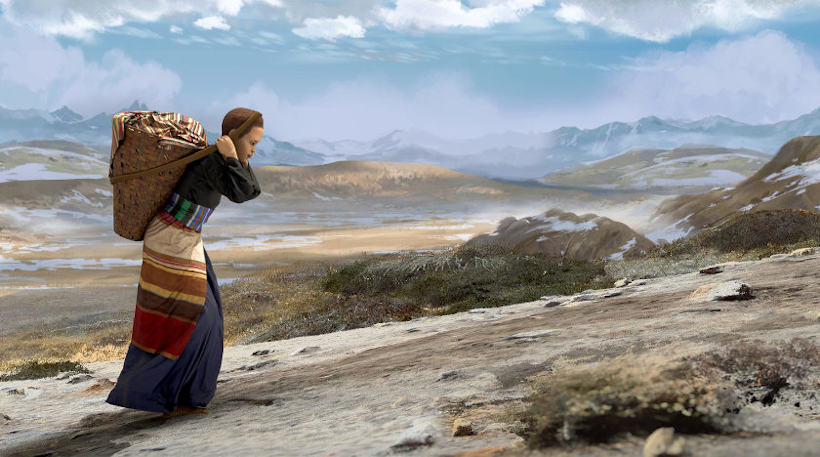
Concerning the lockdown, it really helped for writing, logistically speaking. My problem when it comes to writing is that there is always something else more urgent to do. That is why I did a lot of residencies during the last five years, so that I could extract from daily life and write. Some of them were extreme, like the residency in Sub-Antarctica in 2018, where I had no access to a phone or Internet for five months. So when lockdown happened, I was not afraid of being confined, because I had already isolated myself on purpose before. This is a state I actually look for: time flows differently, the cycle of night and day, the duration of the day, the duration of an hour becomes different. That's the kind of time I'm trying to access when I write. It helps ideas to blossom. The flow of information we are exposed to on a daily basis expanded so much during the last ten years that it is actually beneficial when it stops. In March everything suddenly felt quiet. A little too quiet maybe, because it will eventually become difficult to keep earning enough money to function properly.
VK: We're several months into this situation. Let's move the time clock into 2050. You have a young filmmaker who hasn't experienced this kind of situation, and yet this covid thing happens again. What would be the lesson learned, and your own advice to him?
SR: The young generation is more and more addicted to the digital world. The so-called algorithms that rule this world are made to entertain that addiction. To a parent, that is quite scary... So I think my advice would be to try to remember the world before that era. In, say, the 70s, at the sci-fi peak, the future was always a very technological promise, with holograms etc... It was actually quite an accurate guess of the times we live now.
But the new future we are starting to glimpse might not be that technological. Maybe we should now learn again about animal traction, and how to draw with homemade charcoal, because these types of knowledge might soon prove useful. Confinement reconnected me with the elders of my home town, who know how to grow their own food... I could see that they would be more prepared for what's coming than we are. This is the irony of the collapse: it is the least prepared generation that will have to face it.
-
Read Also: Our Interview Series on Independent Animation Online (Indie Online 2020 Research Project)
About Simon Rouby
Born in 1980, Simon Rouby learned to paint the hard way, that is to say; with a spray can. He then went on to study Animation at the famed Gobelins school in Paris as well as Calarts in Los Angeles. Adama, his first feature film was nominated for the Cesars and European Film Awards in 2015 and then went on to be projected in over 100 countries around the world, winning over 10 prizes. In 2017, he was awarded a one year fellowship at the French Academy of Villa Medici in Rome where he developed a new body of work using video installation. He will be a resident at Villa Kujoyama in Kyoto in 2021.
The interview was conducted October 2020 (interviewer Vassilis Kroustallis). It is part of the Indie Online 2020 research project, headed by Michelle Kranot and supported by The Animation Workshop/VIA University College, Center for Animation, Visualization and Digital Storytelling, Denmark.Viborg.




